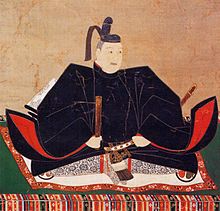Tokugawa Hidetada
Tokugawa Hidetada | |
|---|---|
 | |
| 2nd Edo shogun | |
| In office 1605–1623 | |
| Monarch | Go-Yōzei |
| Preceded by | Tokugawa Ieyasu |
| Succeeded by | Shogun: Tokugawa Iemitsu |
| Personal details | |
| Born | May 2, 1579 |
| Died | March 14, 1632 (aged 52) |
| Relations | Father: Tokugawa Ieyasu Mother: Saigō-no-Tsubone |
| Children | Senhime Tamahime Katsuhime Hatsuhime Tokugawa Iemitsu Tokugawa Tadanaga Hoshina Masayuki Others |
Tokugawa Hidetada (徳川 秀忠, May 2, 1579 – March 14, 1632) was the second shogun of the Tokugawa dynasty, who ruled from 1605 until his abdication in 1623. He was the third son of Tokugawa Ieyasu, the first shogun of the Tokugawa shogunate.
Early life (1579–1593)
Tokugawa Hidetada was born to Tokugawa Ieyasu and the Lady Saigo (the first of his many consorts) in 1579. His exact birthdate is unknown. This was shortly after Hidetada's stepmother (Ieyasu's official wife) and his half-brother Tokugawa Nobuyasu were executed on suspicion of plotting to assassinate Oda Nobunaga, who was Nobuyasu's father-in-law and Ieyasu's ally. By killing his wife and son, Ieyasu declared his loyalty to Nobunaga.
The traditional power base of the Tokugawa clan was Mikawa. In 1590, the new ruler of Japan, Toyotomi Hideyoshi enlisted Tokugawa Ieyasu and others in attacking the domain of the Hōjō in what became known as the Siege of Odawara (1590). Hideyoshi enlisted Ieyasu for this campaign by promising to exchange the five provinces under Ieyasu's control for the eight Kantō provinces, including the city of Edo. In order to keep Ieyasu from defecting to the Hōjō side (since the Hōjō and the Tokugawa were formerly on friendly terms), Hideyoshi took the eleven-year-old Nagamaru as a hostage. In 1592 Hideyoshi presided over Nagamaru's coming of age ceremony; it was then that Ieyasu's son dropped his childhood name, Nagamaru, and assumed the name Hidetada. He was named the heir of the Tokugawa family, being the eldest surviving son of Ieyasu, and his favorite (since Ieyasu's eldest son had been previously executed, and his second son was adopted by Hideyoshi while still an infant). In 1593, Hidetada returned to his father's side.
Early Military Achievements and Sekigahara (1593–1605)
Knowing his death would come before his son Toyotomi Hideyori came of age, Hideyoshi named five regents—one of whom was Hidetada's father, Ieyasu—to rule in his son's place. Hideyoshi hoped that the bitter rivalry among the regents would prevent any one of them from seizing power. But after Hideyoshi died in 1598 and Hideyori became nominal ruler, the regents forgot all vows of eternal loyalty and were soon vying for control of the nation. Tokugawa Ieyasu was one of the strongest of the five regents, and began to rally around himself an Eastern faction. A Western faction rallied around Ishida Mitsunari. The two factions clashed at the Battle of Sekigahara, which set the stage for Tokugawa rule.
In 1600 Hidetada led 16,000 of his father's men in a campaign to contain the Western-aligned Uesugi clan in Shinano. Ieyasu then ordered Hidetada to march his troops to Sekigahara in anticipation of the decisive battle against the Western faction. But the Sanada Clan managed to tie Hidetada's forces down, meaning that he arrived too late to assist in his father's narrow but decisive victory. Hidetada and Ieyasu's relationship never recovered.
In 1603 Emperor Go-Yozei granted Ieyasu the title of shogun. Thus Hidetada became the heir to the shogunate. In 1605 Ieyasu abdicated as shogun in favor of Hidetada.
Shogun Hidetada (1605–1623)
In order to avoid his predecessor's fate, Ieyasu established a dynastic pattern soon after becoming shogun by abdicating in favor of Hidetada in 1605. Ieyasu retained significant power until his death in 1616; but Hidetada nevertheless assumed a role as formal head of the bakufu bureaucracy.[1]

After Hidetada became shogun he married Oeyo (of the Oda family of the Taira clan) and they had two sons, Tokugawa Iemitsu and Tokugawa Tadanaga. They also had two daughters, one of whom, Sen hime, married twice. The other daughter, Kazuko hime, married Emperor Go-Mizunoo {of descent from the Fujiwara clan}.[2]
Much to the dismay of Ieyasu, in 1612, Shogun Hidetada engineered a marriage between Sen hime, Ieyasu's favorite granddaughter, and Toyotomi Hideyori, who was living as a common citizen in Osaka Castle with his mother. When this failed to quell Hideyori's intrigues, Ōgosho Ieyasu and Shogun Hidetada brought an army to Osaka.[3] Father and son once again disagreed on how to conduct this campaign against the recalcitrant Toyotomi forces in Osaka. Ieyasu favored a conservative approach while Hidetada preferred a direct, all-out assault. Hidetada prevailed; in the ensuing siege Hideyori and his mother were forced to commit suicide. Even Hideyori's infant son (Kunimatsu), grandson of Hidetada, was not spared. Ieyasu never forgave Hidetada for this loss. Only Sen hime was spared; she later re-married and had a new family.
After Ieyasu's death in 1616,[3] Hidetada took control of the bakufu. He strengthened the Tokugawa hold on power by improving relations with the Imperial court. To this end he married his daughter Kazuko hime to Emperor Go-Mizunoo.[3] The product of that marriage, a girl, eventually succeeded to the throne of Japan to become Empress Meishō. The city of Edo was also heavily developed under his reign.
Ogosho Hidetada (1623–1632)

In Genna 9 (1623) Hidetada resigned the government to his eldest son and heir, Tokugawa Iemitsu.[4] Like his father before him, Hidetada became Ogosho, or Retired Shogun, and retained effective power. He enacted draconian anti-Christian measures, which Ieyasu had only considered: he banned Christian books, forced Christian daimyo to commit suicide, ordered all other Christians to apostatize, and executed the fifty-five Christians (both Japanese and foreign) who refused to renounce Christianity or to go into hiding, in Nagasaki in 1628.
Ogosho Hidetada died in Kan'ei 9, on the 24th day of the 1st month (1632).[4]
Eras of Hidetada's bakufu
The years in which Hidetada was shogun are more specifically identified by more than one era name or nengō.[3]
Notes
- ^ Titsingh, I. (1834). Annales des empereurs du Japon, p. 409.
- ^ NHK has announced that its 2011 Taiga drama will be named Gō: Himetachi no Sengoku; and it will be based on the life of Oeyo, who was the mother of Tokugwa Masako -- see 大河ドラマ 第50 作 江(ごう) 姫たちの戦国; "Atsuhime"-Autorin für NHKs 2011er Taiga-Drama gewählt (citing Tokyograph), J-Dorama.
- ^ a b c d Titsingh, p. 410. Cite error: The named reference "t410" was defined multiple times with different content (see the help page).
- ^ a b Screech, T. Secret Memoirs of the Shoguns: Isaac Titsingh and Japan, 1779-1822. p.85.
References
- Screech, Timon. (2006). Secret Memoirs of the Shoguns: Isaac Titsingh and Japan, 1779-1822. London: RoutledgeCurzon. ISBN 0-7007-1720-X
- Titsingh, Isaac. (1822). Illustrations of Japan. London: Ackerman.
- Titsingh, Isaac, ed. (1834). [Siyun-sai Rin-siyo/Hayashi Gahō, 1652], Nipon o daï itsi ran; ou, Annales des empereurs du Japon Paris: Oriental Translation Fund of Great Britain and Ireland.
- Totman, Conrad. (1967). Politics in the Tokugawa bakufu, 1600-1843. Cambridge: Harvard University Press.

